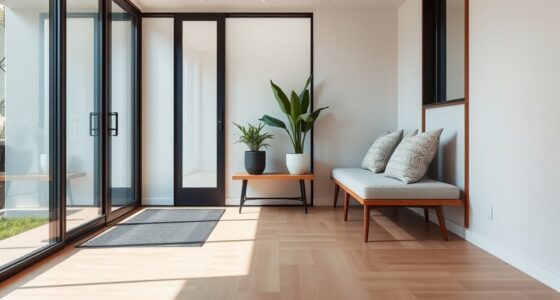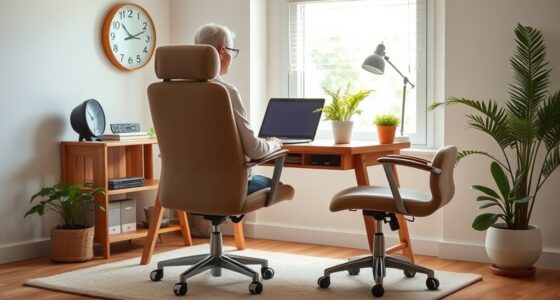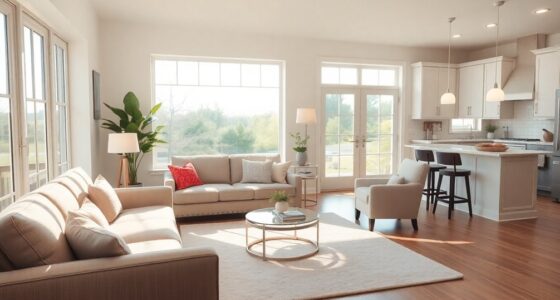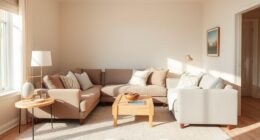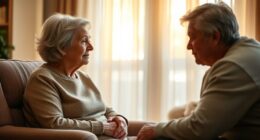To create a safe haven for seniors, focus on accessibility and security throughout the home. Start with safe entryways by installing grab bars and ensuring slip-resistant floors. Proper lighting can prevent falls, so use motion-sensor lights and bright fixtures. Enhance mobility with clear pathways and comfortable bathroom adaptations. Don't forget about elder-friendly staircases with sturdy handrails and visible steps. Ready to explore more essential design solutions that promote safety and comfort?
Key Takeaways
- Install grab bars in bathrooms and near stairs to provide essential support and stability for seniors.
- Utilize non-slip flooring throughout the home to reduce the risk of slips and falls.
- Incorporate bright, glare-free lighting and motion-sensor lights to enhance visibility in all areas.
- Opt for walk-in showers and comfort-height toilets to facilitate easier access and improve bathroom safety.
- Regularly assess and clear walkways of tripping hazards like loose rugs and clutter for a safer living environment.
Understanding Our Needs As We Age
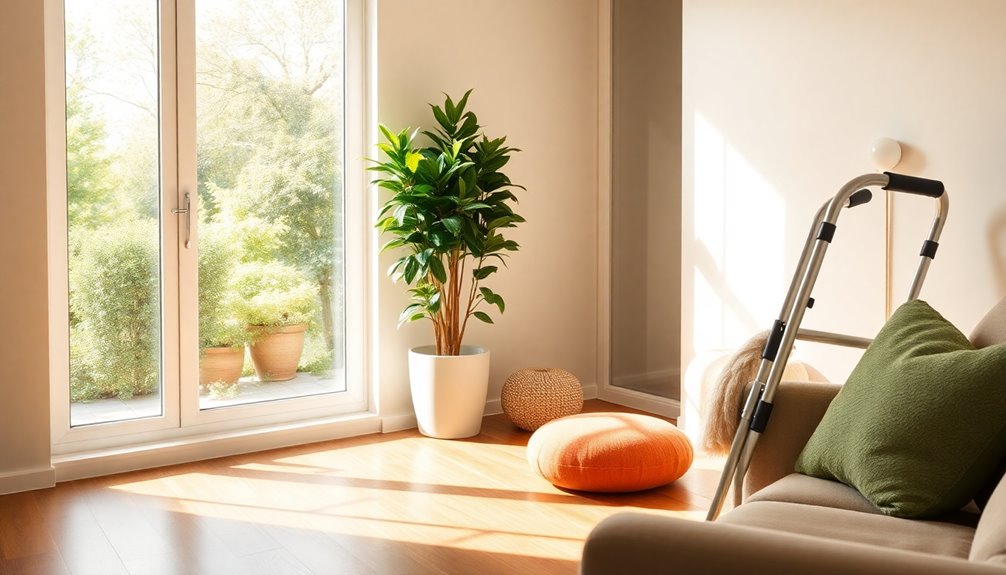
As we age, you might notice that certain daily tasks become more challenging due to reduced mobility, vision loss, or balance issues.
To maintain a safe living environment, it's vital to address these unique needs with thoughtful home modifications. Unmodified homes can pose significant risks, so prioritizing safety becomes essential.
Common modifications like installing grab bars in bathrooms, adding non-slip flooring, and ensuring adequate lighting can help mitigate hazards. Additionally, incorporating clearance requirements for appliances and furniture can further enhance safety and accessibility.
A thorough, room-by-room evaluation by certified Senior Home Safety Specialists® can identify potential dangers and provide tailored solutions.
Creating Safe and Accessible Entryways
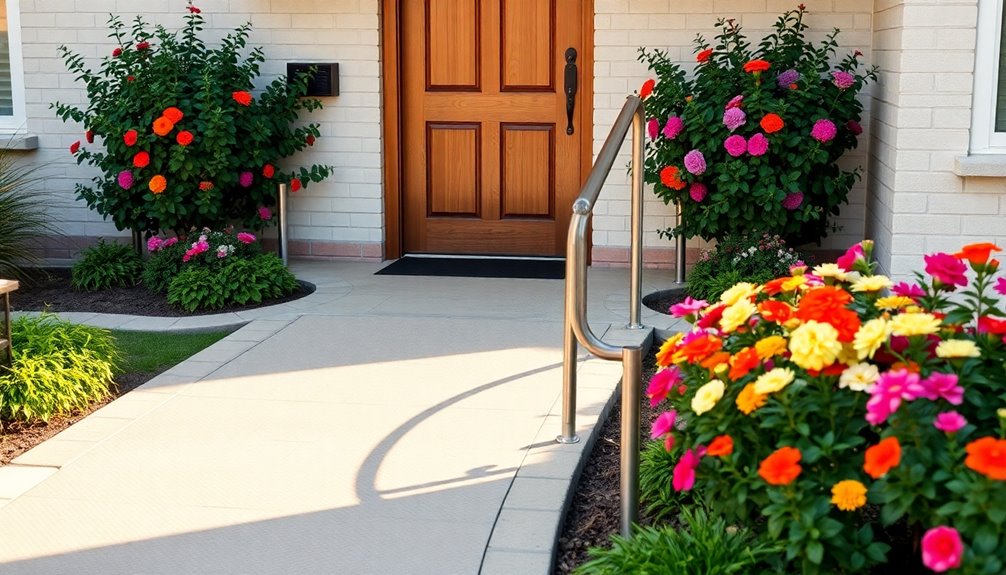
When it comes to entryways, proper lighting and slip-resistant surfaces are essential for safety. You want to guarantee that every entrance is well-lit, especially in low visibility, to prevent any falls or accidents. Additionally, incorporating long-term financial planning can help families invest in necessary home modifications to enhance safety for their elderly loved ones.
Importance of Adequate Lighting
Adequate lighting in entryways is essential for preventing trips and falls, especially for older adults who may struggle with vision or balance.
Proper lighting not only enhances home safety but also makes navigation easier in low-light conditions. Installing bright, glare-free fixtures guarantees that seniors can see obstacles and safely enter their homes.
Consider adding motion-sensor lights that automatically illuminate the area as they approach, greatly reducing accident risks.
It's also wise to illuminate house numbers clearly, aiding visibility for both residents and emergency responders.
Well-lit walkways create a welcoming atmosphere, making seniors feel more secure as they return home.
Prioritizing adequate lighting is a simple yet effective way to enhance safety and comfort in entryways. Additionally, incorporating air purifiers can further improve indoor air quality, promoting respiratory health for seniors in their homes.
Designing Slip-Resistant Surfaces
Creating safe and accessible entryways involves prioritizing slip-resistant surfaces, which are essential in preventing falls among seniors.
With about 30% of seniors experiencing falls each year, addressing slippery surfaces is vital to reduce the risk of serious injuries.
Consider using textured pavers or rubberized coatings on outdoor pathways to enhance traction, especially in wet conditions.
Regularly clean and seal these surfaces to maintain their slip-resistant qualities.
Additionally, install motion-activated lights to illuminate walkways, helping to identify potential hazards.
Incorporating slight inclines and proper drainage systems can further keep entryways dry, minimizing the chance of slipping.
Furthermore, implementing proper insulation can help maintain a consistent surface temperature, reducing the risk of condensation and subsequent slipperiness.
Installing Proper Lighting

When you're installing lighting for seniors, bright, glare-free fixtures are a must to guarantee safety and comfort. Consider adding motion-sensor lights to automatically brighten pathways, making navigation easier at night. These simple changes can greatly enhance visibility and reduce the risk of falls in your home. Additionally, ensuring that regular check-ups are performed on other home systems, like heat pumps, can further enhance safety by preventing unexpected failures.
Bright, Glare-Free Fixtures
Proper lighting is essential for ensuring safety and comfort in a senior's home, especially in areas like entryways and staircases where visibility is often poor.
Installing bright, glare-free fixtures greatly improves visibility, helping prevent accidents and falls. By using high-contrast lighting—like bright lights against darker walls—you enhance depth perception and spatial awareness for those with vision impairments.
Additionally, incorporating LED strip lights along stair edges and in dark corners clearly marks boundaries, reducing the risk of missteps. Adequate lighting in these high-traffic areas can decrease accidents by up to 50%. Furthermore, a clean and organized living space can promote better sleep quality, which is crucial for seniors' overall health and well-being.
Prioritizing these bright, glare-free lighting solutions creates a safer living environment, allowing seniors to navigate their homes with confidence and ease.
Motion-Sensor Lighting Benefits
Bright, glare-free fixtures set the foundation for safe navigation in a senior's home, but adding motion-sensor lighting takes safety a step further.
These lights automatically illuminate when you approach, greatly reducing the risk of trips and falls, especially in dimly lit areas. For seniors facing mobility challenges, hands-free operation enhances safety, particularly on stairways and near entryways.
By installing motion-sensor lights in high-traffic zones, you'll improve visibility, which is vital for those with reduced vision or impaired depth perception.
Plus, many systems are energy-efficient, activating only when needed, which can lower electricity costs.
Strategically placing these lights along walkways and entrances also aids emergency responders, ensuring homes remain safe and accessible during low-light situations. Additionally, incorporating effective relaxation techniques can further enhance a senior's comfort and well-being in their environment.
Enhancing Mobility Throughout the Home

To enhance mobility throughout the home, small changes can make a big difference in your daily life. Start by upgrading to lever-style door handles, which require less hand strength.
Evaluate your flooring for slip-resistance; consider non-slip treatments or low-pile carpeting to reduce tripping hazards. Rearranging furniture can create clear pathways, making navigation safer.
Installing ramps or lifts at entryways guarantees easy access for those using walkers or wheelchairs. Finally, incorporate contrasting colors for walls, floors, and furniture to improve depth perception, especially for seniors with vision challenges. Additionally, regular maintenance of the home environment can help ensure safety features remain effective and functional over time.
- Install grab bars in bathrooms.
- Use non-slip mats in slippery areas.
- Keep pathways clear of clutter.
- Choose furniture with rounded edges.
- Ensure adequate lighting in all areas.
Designing Elder-Friendly Staircases
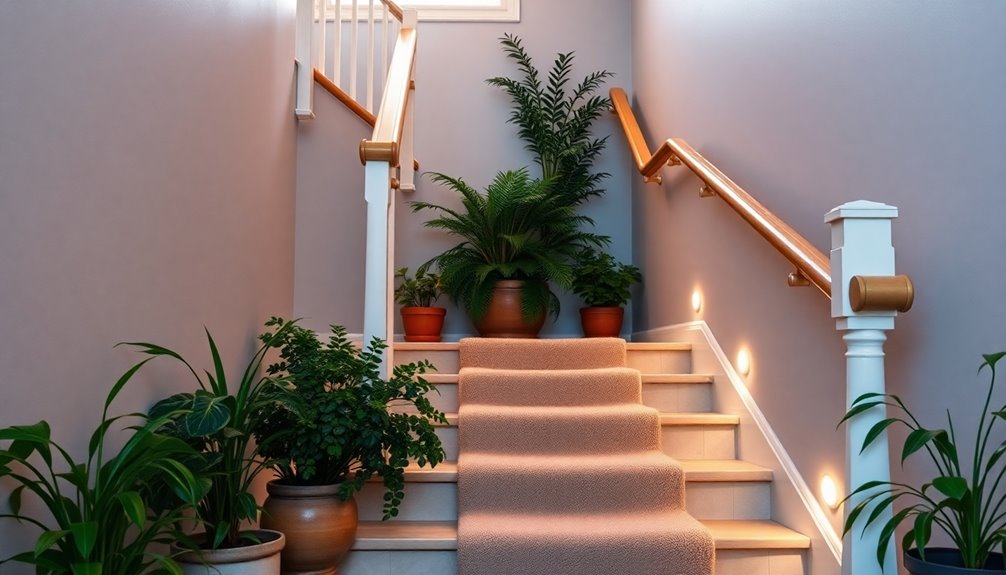
When designing elder-friendly staircases, installing handrails on both sides is a must for safety and support. You can enhance visibility by using contrasting colors for stair treads, making each step easier to see. Don't forget to maintain these features regularly to keep the environment safe for seniors. Additionally, ensuring proper toilet maintenance can help prevent accidents in nearby restrooms, contributing to an overall safe living space.
Handrail Installation Guidelines
Installing handrails on both sides of staircases not only enhances safety but also boosts users' confidence as they navigate steps.
To guarantee handrails are suitable for older adults, follow these installation guidelines:
- Choose a diameter between 1.25 to 2 inches for easy gripping.
- Securely anchor handrails to prevent wobbling or detachment.
- Extend handrails at least 12 inches beyond the top and bottom steps for added support.
- Use contrasting colors to improve visibility against wall surfaces.
- Comply with local building codes regarding height (34 to 38 inches) and load-bearing capabilities. Additionally, consider the cost of home security systems to further enhance the safety of the environment for seniors.
Stair Visibility Enhancements
Maneuvering stairs can be a challenging task for seniors, but effective visibility enhancements can make a significant difference.
Thoughtful design choices like installing handrails on both sides of the staircase provide essential support, reducing fall risks. Opting for contrasting colors between stair treads and surrounding walls boosts visibility, making navigation easier.
You should make certain handrails extend beyond the top and bottom steps, offering extra support when moving between levels. Incorporating motion-sensor lighting at both ends guarantees well-lit stairs, enhancing safety during nighttime use.
Additionally, LED strip lights along the edges of steps improve visibility, preventing missteps. By implementing these strategies, you create a safer staircase environment that promotes independence and confidence for seniors.
Optimizing Stairway Lighting

To guarantee safety while traversing stairways, effective lighting is essential. Well-lit stairways prevent accidents and create a safe environment.
To optimize your stairway lighting, consider these solutions:
- Install overhead lights for even illumination.
- Use motion-sensor lights to automatically light your stairs at night.
- Place clear lighting at the top and bottom to mark boundaries.
- Add LED strip lights along the edges of steps for improved visibility.
- Regularly maintain your lighting by replacing burnt-out bulbs and cleaning fixtures.
Adapting Bathrooms for Increased Safety

While optimizing stairway lighting is essential for safety, the bathroom often poses even greater challenges for seniors. To enhance safety in this essential space, consider these adaptations:
| Feature | Benefits | Purpose |
|---|---|---|
| Grab Bars | Provides stability and support | Reduces fall risk |
| Walk-in Showers | Facilitates easier access | Encourages independence |
| Non-slip Surfaces | Prevents slips | Enhances safety |
Choosing Appropriate Fixtures

How can you guarantee your bathroom fixtures are both functional and safe for seniors?
Start by selecting fixtures that enhance ease of use and provide additional support.
Opt for walk-in showers or low-threshold tubs to minimize fall risks. Handheld showerheads offer flexibility, allowing seniors to bathe comfortably.
Choose comfort-height toilets, 17 to 19 inches off the ground, to make sitting and standing easier. Single-handle faucets reduce scalding risks and simplify operation.
Ascertain all fixtures, like grab bars and handles, feature non-slip surfaces for secure grips.
- Walk-in showers or low-threshold tubs
- Handheld showerheads
- Comfort-height toilets
- Single-handle faucets
- Non-slip grab bars and handles
These choices create a safer bathroom environment for seniors.
Optimizing Lighting for Aging Eyes
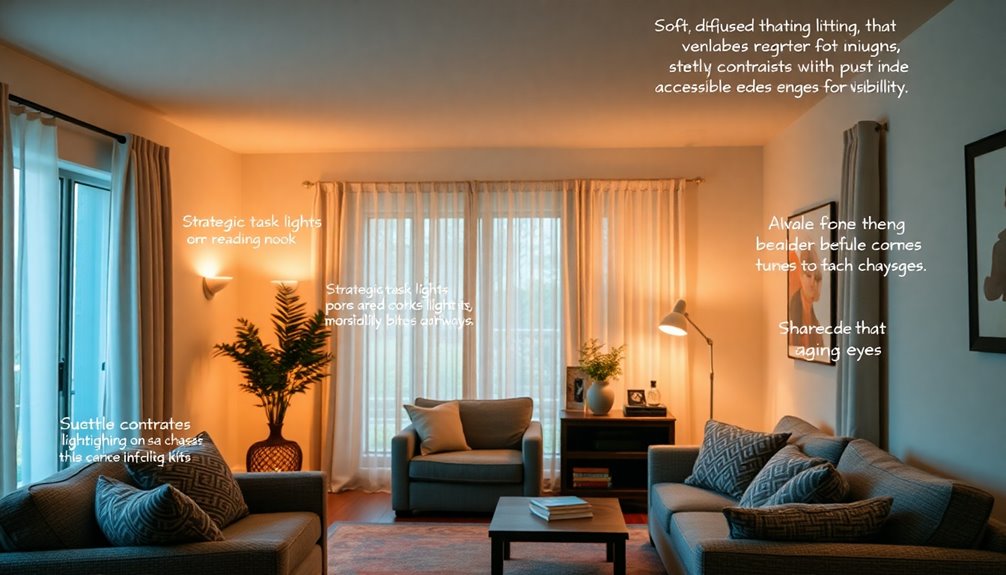
As seniors age, their eyes require more light to see clearly, making proper lighting essential for safety and comfort in the home. Bright, glare-free lighting fixtures improve visibility, particularly in high-traffic areas. Strategic placement of task lighting helps with activities like reading or cooking, maintaining independence.
| Lighting Type | Benefits | Recommended Areas |
|---|---|---|
| Ambient Lighting | General illumination | Living rooms, bedrooms |
| Task Lighting | Focused light for activities | Kitchens, reading nooks |
| Accent Lighting | Highlights hazards and boundaries | Stair edges, hallways |
Consider installing motion-sensor lights for automatic illumination in hallways and using LED strip lights in dark corners. Creating a well-lit environment is essential for enhancing safety and comfort for seniors.
General Safety Tips for Elder-Friendly Design
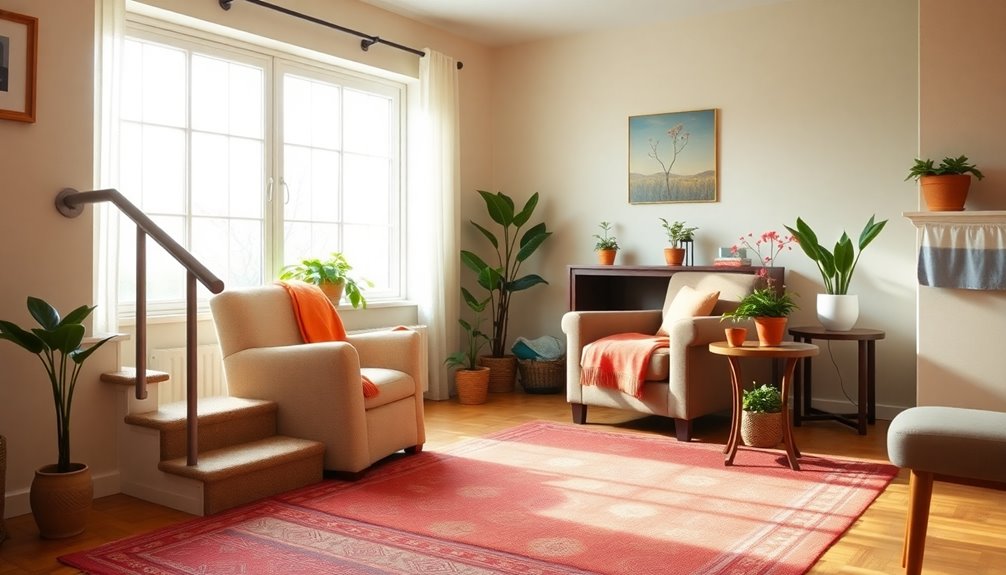
Creating a safe and accessible home for seniors involves thoughtful design choices that prioritize mobility and reduce risks.
By enhancing the home environment, you can help seniors maintain independence while minimizing hazards. Here are some essential tips to reflect on:
- Regularly evaluate the home layout for accessibility improvements.
- Install grab bars in bathrooms and near stairs for stability.
- Confirm adequate lighting in hallways and stairways to enhance visibility.
- Remove tripping hazards like loose rugs and cluttered walkways.
- Use lever-style door handles instead of traditional knobs for easier operation.
Implementing these strategies not only creates a safer living space but also encourages confidence and autonomy for older adults in their daily activities.
Frequently Asked Questions
What Are the Best Materials for Non-Slip Flooring?
When considering non-slip flooring, think about materials that provide both safety and comfort.
Vinyl is a popular choice due to its durability and slip-resistant texture.
Rubber flooring also offers excellent traction and cushioning, ideal for high-traffic areas.
You might also want to explore textured ceramic tiles, which can enhance grip.
Finally, bamboo is an eco-friendly option that can be treated for slip resistance, adding style while keeping safety in mind.
How Can I Encourage Social Interaction Among Seniors in Their Living Space?
To encourage social interaction among seniors in their living space, you can create inviting communal areas with comfortable seating.
Organize group activities like game nights or book clubs that spark conversation.
Incorporating shared spaces, like a garden or kitchen, helps build community.
You might also consider using technology, like video calls, to connect them with family and friends.
What Ergonomic Furniture Options Are Available for Seniors?
When considering ergonomic furniture options for seniors, you should look for chairs and sofas with adjustable heights and good lumbar support.
Recliners that are easy to get in and out of can make a big difference.
Tables at the right height help reduce strain while eating or working.
Also, consider furniture with rounded edges to prevent injuries.
Soft, non-slip materials can enhance comfort and safety in their living space.
How Can Technology Enhance Safety for Seniors at Home?
Imagine stepping into your home, surrounded by smart devices that keep you safe.
Technology can enhance your safety by integrating motion sensors that light up dark hallways, or installing smart locks that you control with your phone.
You can use wearable alerts to notify loved ones in case of emergencies.
Voice-activated assistants help you call for help or remind you to take medication, creating a secure and comforting environment for you.
What Mindful Activities Can Seniors Engage in to Promote Mental Well-Being?
To promote mental well-being, you can engage in various mindful activities like meditation, yoga, or gentle stretching.
Try journaling your thoughts and feelings, or practice deep breathing exercises to center yourself.
Art activities like painting or coloring can also be therapeutic.
Joining a book club or participating in group discussions helps stimulate your mind and connect with others.
Conclusion
So, if you're ready to turn your home into a fortress of safety for seniors, just remember: it's all about creating a space where tripping over a rug isn't the most dangerous thing they'll face! With a sprinkle of proper lighting and a dash of elder-friendly design, you can transform any abode into a senior haven. After all, who needs adventure when you've got grab bars and non-slip mats? Safety first, thrill-seeking later!



